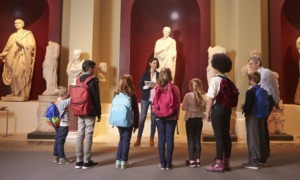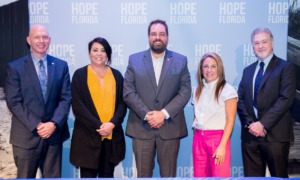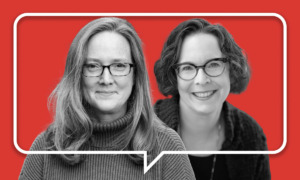Baltimore, Md.—In 1954, a U.S. Senate subcommittee summoned child psychologists and comic book publishers to hearings on a matter of grave national concern: the harm that comics were doing to children.
Focusing on titles like Haunted Thrills and Tales from the Crypt, the senators concluded in a committee report: “This country cannot afford the calculated risk involved in feeding its children, through comic books, a concentrated diet of crime, horror, and violence.” The senators were also troubled by images in comics of “scantily clad females in suggestive poses.”
Fifty years later, 21 youth workers from 10 after-school programs gather at Baltimore’s After-School Institute for a workshop on teaching kids to create … comic books.
“The parents are very excited that we’re doing this,” Doris Johnson, director of Baltimore’s Beacon After-School Child Care, says at the November workshop. “And some of the children who usually don’t participate [in group activities] are excited.”
The once-maligned comic book, confiscated over the years from many a child as classroom contraband, has evolved into a tool for youth-driven education and youth development. While adults have long used comics to reach kids with lessons about such scourges as child abuse and drugs, a small but growing number of youth programs are helping kids create comic books to reach other kids.
Pushing the evolution as much as anyone is Michael Bitz, the 33-year-old founder and director of the Comic Book Project, which has spread from New York City to 11 other cities in the past four years. The project, which conducted the Baltimore workshop, helps kids produce comics as a means of exploring their artistic and organizational skills, improving their writing, practicing self-discipline and taking on issues of importance to youth.
Dark Horse Comics – publisher of Conan the Barbarian and Terminator – plans to publish 10,000 copies of the best comic books produced by the youths.
Youths also produce comics through other programs at the 92nd Street Y in Manhattan and the New York City Comic Book Museum. (See resources, below.)
These efforts go beyond the belief that comic books can effectively deliver social messages to kids, á la the adventures of McGruff the Crime Dog and the special Spiderman episodes produced with Prevent Child Abuse America. They are based on the faith, and a bit of evidence, that the production of an artistic product is an effective tool of youth development.
It’s a Mad World
That’s a long way from the attitude in 1954, when psychiatrist Fredric Wertham published a book called Seduction of the Innocent, which portrayed comics as how-to manuals for crime and depravity. The author found a “subtle atmosphere of homoeroticism” in Batman and Robin.
Wertham’s work was prominently featured in the hearings on comic books and youth conducted by the Senate Subcommittee on Juvenile Delinquency. The hearings focused primarily on crime and horror comics, and several experts testified that delinquency had causes other than comics. Nevertheless, comic book publishers, fearing control from Washington, adopted a code prohibiting violence, sex or sympathetic depiction of criminals.
“In every instance,” the code proclaimed, “good shall triumph over evil and the criminal punished for his misdeeds.”
Distributors refused to carry comics without the seal of the new code, prompting the disappearance from shelves of comics filled with dramatic images of horror and gore. One rebellious comic book, Tales Calculated To Drive You MAD, got around the restrictions by converting itself into a magazine, according to published histories of the periodical. It became MAD Magazine. MAD Publisher William Gaines had faced off against Sen. Estes Kefauver (D-Tenn.) at the 1954 hearings. The subcommittee gathered copies of the MAD comic book as evidence.
Anyone who thinks today’s adults are overwrought about the harm done to kids by pop culture might take heart in MAD’s rise over the subsequent decades into a national icon. When the National Archives mounted an exhibit in 1997 called “American Originals,” one of the prime items was the first issue of MAD. The display was in the archives’ main rotunda, where the U.S. Constitution and the Declaration of Independence are also on view.
From Devil to Hero
By that time, youth-focused organizations and even the federal government had turned to the comic book format as a way to communicate with youth about problems.
• In 1971, three Amazing Spiderman comic books featured a strong anti-drug message and were credited with persuading publishers to liberalize the 1954 code. Under the old rules, “you could not show drug use, even to denounce it,” says Gene Kannenberg, assistant professor of English at the University of Houston, who runs comicsresearch.org, an Internet-based research bibliography.
• In 1974, Alateen published a comic book for kids called If Your Parents Drink Too Much. The publication was re-released last year, redrawn to look more contemporary.
• In 1983, the federal government sponsored New Teen Titans, a giveaway comic book that aimed to steer youths from drug use. Funded by Keebler, the cookie company, in cooperation with the National Federation of Parents for Drug-Free Youth and the President’s Drug Awareness Campaign, the comic included a letter from first lady Nancy Reagan to “just say no” to drugs.
• In 1984, Prevent Child Abuse America sponsored a special-edition Amazing Spiderman comic dealing with child abuse. “The Peter Parker character [Spiderman] was revealed to have been abused as a child,” says Kevin Kirkpatrick, Prevent Child Abuse America’s vice president for communications and advancement.
Prevent Child Abuse and Marvel Comics, the publisher of Spiderman, have cooperated on five subsequent special editions dealing with youth issues. The special editions are printed in lots of 50,000, with the expectation that churches, healthcare centers or others will buy them at a bulk rate ($1.13 each for 5,000, for instance) and give them to kids.
Last year’s edition on bullying was initially supported by an $80,000 grant from Target. The comics are printed and marketed by Channing-Bete, a Massachusetts company that specializes in publications for schools, organizations and government agencies. Prevent Child Abuse shares in the proceeds after the expenses are covered.
• Since the late 1980s, the National Crime Prevention Council, with funding from the U.S. Justice Department’s Bureau of Justice Assistance, has taken on bullying and crime in 20-page comic-like activity books featuring McGruff “the Crime Dog.” Recent editions, aimed at kids from 7 to 11, deal with issues such as what to do if you find a gun or are inappropriately contacted by an adult on the Internet.
The council has published more than 1 million copies of Volume III, which deals with bullying and was first released in 1999. Critics occasionally protest that the crime issues kids face are too serious to be resolved in comic books. “But we know that comic books are seen as something of value to a child,” says John Rosiak, the council’s director of international initiatives. “All kids trust McGruff.”
• Teachers around the country use comics and their more complicated and longer cousin, the graphic novel, to reach reluctant readers. In Maryland, state education officials say that a comic book-based curriculum being used in some suburban districts will be taken statewide this fall.
Yet comic books are put to social and educational uses far less in the United States than in many other countries. The Center for Communications Programs at the Johns Hopkins Bloomberg School of Public Health has a collection of 153 comic books on health information. Many are from Brazil, Kenya, Nepal and the Philippines.
“Many of the readers are adolescents. That’s why it’s such a good medium for information about reproductive health,” says Hugh Rigby, chief of the center’s Media/Materials Clearinghouse.
Only one of the comics in the center’s collection is from the United States: Relaciones, an AIDS information comic in Spanish that was written by adolescents and published in 1992 by AIDS Project Los Angeles. It is no longer available.
The Act of Creation
Enter Bitz, a senior research associate at Columbia University’s Teachers College, whom The New York Post described as “a mild-mannered educator” turned “teaching superhero.”
Bitz started his project in 2001 with 15 kids in an after-school program at Junior High 126 in Queens, N.Y. The idea caught on as if boosters of after-school programs had been waiting for it.
The following year, with technical support from New York’s After-School Corp., the Partnership for After-School Education and the Fund for the City of New York, Bitz expanded the project to 33 more after-school programs around the city. In 2003 he added 20 more in New York and started in 31 public schools in Cleveland. Last year the project expanded to 10 more cities. Each year, the project sets a theme for kids to address in their comics.
“We want kids to think about important issues,” Bitz says. The theme has also helped attract grants. Last’s year’s environmental theme in New York was backed by a $56,000 grant from the U.S. Environmental Protection Agency. In Cleveland, an anti-violence theme drew a $50,000 grant from the Cleveland Foundation in 2003; the teamwork theme for this school year won a $45,000 grant from the foundation.
The Comic Book Project’s national budget is $160,000, supported by grants and The After-School Corp. Columbia Teachers College hosts the project, providing office space, technical assistance and some financial help.
The project provides each new class or after-school program with 10 free copies of its basic materials, including a lesson plan for 16 sessions, each lasting about 45 minutes. There’s a charge for subsequent materials.
The handouts include an Activity Booklet that introduces simple drawing skills and facial expressions, and several comic book-like panels on which to practice. Bitz repeatedly insists that advanced drawing skill is not required. After a few training exercises at the Baltimore workshop, he looks at the assembled youth workers and says, “Who can’t do that?”
Writing can be a bigger hurdle. Bitz warns the youth workers that the blank spaces that need to be filled in the project’s “Manuscript Starter” can seem formidable to weak writers. A few kids may want to drop out at this point.
“Don’t let them get frustrated over having to write out every word,” he says. “It’s just a draft.”
At the end of the school year, Dark Horse publishes 10,000 copies of the best kids’ work as a genuine comic book. The 2003-2004 environmental comic in New York City was called Save Our City, Save Our Planet. The anti-violence comic book in Cleveland was called Peace in Our Schools. Two comics will be published this year – the teamwork comic from Cleveland, and another from the rest of the participating cities on the theme of leadership.
Results
John Eby, director of arts education for the Cleveland schools, says making comic books is a serious learning experience. “The kids have really gotten into it, and so have the teachers,” he says. “The kids write a book – how’s that for learning the basics? And then they do a tremendously creative interpretation of what they’ve written.”
But even support from educators can’t completely protect this youth development effort from being overridden by academic concerns. At Baltimore’s Beacon After-School Child Care, director Johnson – who attended the training session in November – says eight fifth-graders are enthusiastically completing their work for the Comic Book Project this year. But several fourth-graders dropped out, she says, because “the kids have so much homework, and some parents want the homework done at the center.”
Which raises the question: In an evaluation-driven funding environment, does producing comics produce measurable results? There are no studies on the impact of comic book programs. There is some evidence that arts and media projects have positive, measurable impacts on youth. (See Comic Effect, page 30.)
Some say the benefits of creating comics might not be measurable.
“We’re so rigid these days, worrying about test scores,” says Dan Tandarich, a Brooklyn teacher who started a comics creation curriculum called COMICS (Challenging Objective Minds: an Instructional Comic Book Series). “We’re missing out on creativity – the idea of facing a blank piece of paper and having to create something.”
He notes, “The kids are often excited to discover that comic books exist.”
Which points to an irony: Few kids read comic books these days. Lee Dawson, publicist for Dark Horse Comics, defines today’s comic book audience as “18- to 34-year-olds.”
“There just aren’t many comic books designed for children,” says Kannenberg of comicresearch.org. “Comics for kids started to die out in the 1970s.”
So now adults are trying to show kids that comic books can be contribute to their healthy development.
Resources
Michael Bitz The Comic Book Project New York, NY (212) 330-7444 www.comicbookproject.org meb53@columbia.edu C.O.M.I.C.S. New York City Comic Book Museum www.nyccomicbookmuseum.org/main.htm
Dan Tandarich (718) 788-5964 Tom Hart Story Ark New York, NY (718) 687-7434 www.newhatstories.com/storyark/comics
“Critical Links: Learning in the Arts and Student Academic and Social Development” Arts Education Partnership Washington, DC www.aep-arts.org/PDF%20Files/CriticalLinks.pdf






























